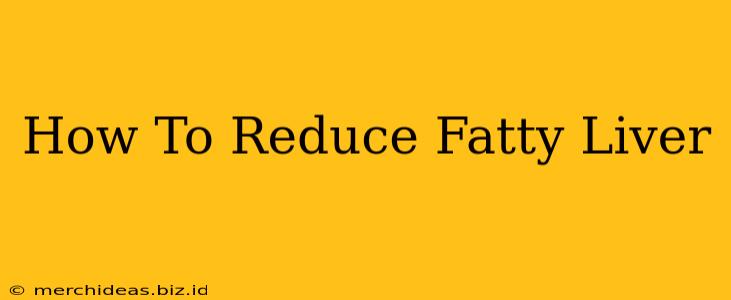A fatty liver, also known as hepatic steatosis, occurs when there's an excessive buildup of fat in the liver. This isn't always a cause for immediate alarm, as some fat in the liver is normal. However, excessive fat accumulation can lead to inflammation and damage, potentially progressing to non-alcoholic fatty liver disease (NAFLD) or even cirrhosis. Understanding how to reduce fatty liver is crucial for protecting your long-term health.
Understanding Fatty Liver: Types and Causes
There are two main types of fatty liver disease:
- Alcoholic Fatty Liver Disease (AFLD): This is caused by excessive alcohol consumption.
- Non-Alcoholic Fatty Liver Disease (NAFLD): This is the more common type, linked to factors like obesity, type 2 diabetes, high cholesterol, and metabolic syndrome. Even people of normal weight can develop NAFLD.
Several factors contribute to the development of fatty liver, including:
- Obesity: Being overweight or obese significantly increases your risk.
- Type 2 Diabetes: High blood sugar levels damage the liver.
- High Cholesterol and Triglycerides: These fats can accumulate in the liver.
- Insulin Resistance: The body's inability to effectively use insulin leads to fat storage in the liver.
- Metabolic Syndrome: A cluster of conditions increasing the risk of heart disease, stroke, and type 2 diabetes.
- Certain Medications: Some medications can contribute to fatty liver as a side effect.
- Rapid Weight Loss: In rare cases, significant and rapid weight loss can also contribute to fatty liver.
Effective Strategies to Reduce Fatty Liver
Fortunately, lifestyle changes can significantly impact fatty liver. Here's a comprehensive approach:
1. Weight Management: The Cornerstone of Treatment
Losing even a modest amount of weight (5-10% of your body weight) can significantly improve liver health. This is arguably the most effective strategy. Focus on gradual, sustainable weight loss through a combination of diet and exercise.
2. Dietary Changes: Fueling Your Liver's Recovery
- Limit Sugary Drinks and Processed Foods: These are major contributors to excess fat storage.
- Increase Fiber Intake: Fiber helps regulate blood sugar and cholesterol levels. Fruits, vegetables, and whole grains are excellent sources.
- Choose Lean Protein Sources: Opt for fish, poultry, beans, and lentils over red meat.
- Healthy Fats are Key: Incorporate monounsaturated and polyunsaturated fats found in avocados, nuts, seeds, and olive oil.
- Limit Saturated and Trans Fats: These are found in many processed foods and should be minimized.
3. Regular Exercise: Boosting Liver Function
Aim for at least 150 minutes of moderate-intensity aerobic exercise per week, such as brisk walking, swimming, or cycling. Incorporate strength training exercises two to three times a week to build muscle mass.
4. Medication and Medical Supervision
In some cases, medication might be necessary to manage underlying conditions like type 2 diabetes or high cholesterol. Always consult your doctor before starting any new medications or supplements. Regular check-ups are crucial to monitor your liver health.
5. Addressing Underlying Health Conditions
Effectively managing conditions such as type 2 diabetes, high cholesterol, and metabolic syndrome is vital in reducing fatty liver. Working closely with your healthcare provider to optimize the management of these conditions is critical.
When to See a Doctor
If you experience symptoms such as fatigue, abdominal pain, jaundice (yellowing of the skin and eyes), or swelling in your legs or ankles, seek immediate medical attention. Early diagnosis and intervention are crucial in preventing complications.
Disclaimer: This information is for educational purposes only and should not be considered medical advice. Always consult with your healthcare provider for diagnosis and treatment of fatty liver disease. They can help you develop a personalized plan based on your individual needs and health status.
